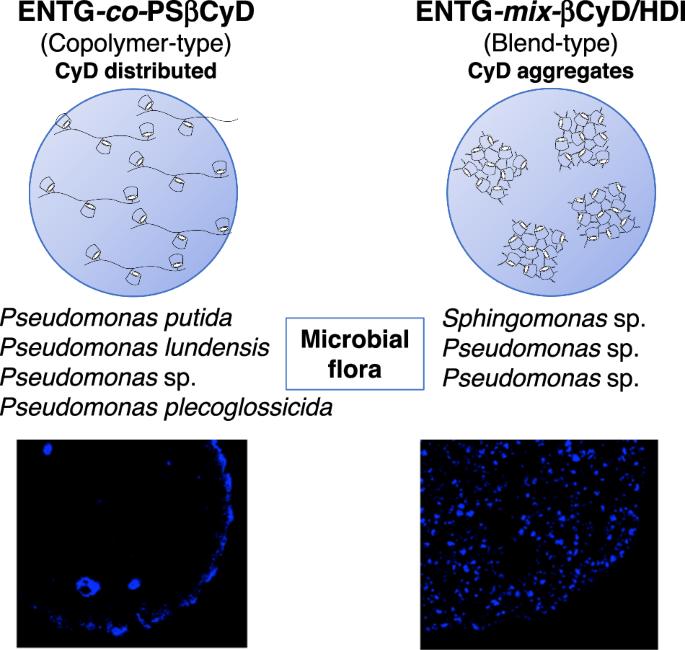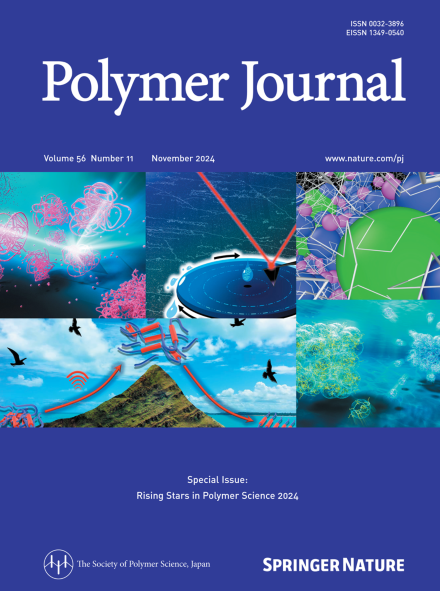Effects of β-Cyclodextrin Introduced by Different Methods on the Immobilized Phenol-Degrading Bacteria in Photocrosslinked Spherical Hydrogels
IF 2.7
4区 化学
Q3 POLYMER SCIENCE
引用次数: 0
Abstract
In this study, we developed two types of lattice-type β-cyclodextrin (β-CyD)-containing spherical hydrogels to immobilize phenol (PhOH)-degrading bacteria. One type, ENTG-mix-βCyD/HDI, consists of mixed-type spherical hydrogels containing β-CyD ring-bearing polymer microparticles embedded within the gel matrix. The other type, ENTG-co-PSβCyD, consists of copolymerized spherical hydrogels in which β-CyD-substituted monomers are copolymerized and crosslinked. The former features an aggregated distribution of β-CyD rings, whereas the latter exhibits a uniform distribution. Continuous PhOH degradation experiments revealed that both of the β-CyD-containing spherical hydrogel catalysts exhibited catalytic activity exceeding that of the ENTG spherical catalyst without β-CyD. Immobilized bacteria were distributed both on the surface and within the structure of the copolymerized carrier, whereas in the mixed carrier, many bacteria were dispersed throughout. Analysis of the PhOH-degrading flora revealed that Pseudomonas putida formed a niche in the copolymerized hydrogels, whereas Sphingomonas sp. formed a niche in the mixed hydrogels. Batch experiments using p-xylene instead of PhOH demonstrated that the degradation rates of the copolymerized and mixed gels were 2.4 times and 1.6 times greater than that of the ENTG gel, respectively. The copolymerized gel exhibited a faster p-xylene degradation rate due to the reactivity of P. putida. Continuous phenol (PhOH) decomposition experiments were carried out with PhOH-degrading bacteria immobilized in a copolymerized spherical hydrogel (ENTG-co-PSβCyD) and a mixed spherical hydrogel (ENTG-mix-βCyD/HDI). Similar to the results obtained from the batch PhOH degradation experiments, both β-CyD-containing spherical hydrogels, which feature cylindrical hydrophobic intramolecular spaces, exhibited higher activity than the ENTG spherical hydrogels lacking β-CyD. The bacterial cells were extensively distributed on the surface and inside the copolymerized carrier and throughout the entire mixed carrier, while only a small amount of bacteria were found on the surface of the ENTG carrier. Furthermore, the PhOH-degrading bacterial flora (microflora) in the copolymerized and mixed spherical gel matrices were identified. Pseudomonas putida formed a niche in the copolymerized spherical hydrogel, and Sphingomonas sp. formed a niche in the mixed hydrogel. In the continuous PhOH degradation experiment, the performance of both hydrogels was almost identical because the ability of both strains to degrade PhOH is similar. However, in the batch removal experiment using p-xylene as the substrate instead of PhOH, the rates of substrate removal by the copolymerized gel and mixed gel 2.4 times and 1.6 times greater than that of the ENTG gel, respectively. This occurred because the bacterial species in the mixed gel was Sphingomonas sp. instead of P. putida, and the high substrate removal by the copolymerized gel was a result of the high reactivity of P. putida.

不同方法引入β-环糊精对光交联球形水凝胶中固定化酚降解菌的影响
本研究制备了两种含β-环糊精(β-CyD)的晶格型球形水凝胶,用于固定化苯酚(phh)降解菌。其中一种是ENTG-mix-βCyD/HDI,它是一种混合型球形水凝胶,其中含有嵌入凝胶基质中的β-CyD环载聚合物微粒。另一种类型是ENTG-co-PSβCyD,由共聚球形水凝胶组成,其中β- cyd取代的单体是共聚和交联的。前者表现为β-CyD环的聚集分布,而后者表现为均匀分布。连续的phh降解实验表明,两种含β-CyD的球形水凝胶催化剂的催化活性均优于不含β-CyD的ENTG球形催化剂。固定化细菌分布在共聚载体的表面和结构内部,而在混合载体中,许多细菌分散在整个载体中。对phh降解菌群的分析表明,恶臭假单胞菌在共聚水凝胶中形成一个生态位,而鞘脂单胞菌在混合水凝胶中形成一个生态位。用对二甲苯代替phh的批量实验表明,共聚凝胶和混合凝胶的降解率分别是ENTG凝胶的2.4倍和1.6倍。由于恶臭假单胞菌的反应性,该共聚凝胶具有较快的对二甲苯降解速率。采用共聚球形水凝胶(entg -co- ps -βCyD)和混合球形水凝胶(ENTG-mix-βCyD/HDI)固定化phh降解菌,对苯酚(PhOH)进行了连续分解实验。与批量phh降解实验的结果相似,两种含有β-CyD的球形水凝胶(具有圆柱形疏水分子内空间)都比缺乏β-CyD的ENTG球形水凝胶表现出更高的活性。细菌细胞广泛分布在共聚载体的表面和内部,并遍布整个混合载体,而在ENTG载体表面仅发现少量细菌。此外,还鉴定了共聚和混合球形凝胶基质中降解phoh的菌群(微生物群)。恶臭假单胞菌在共聚球形水凝胶中形成生态位,鞘脂单胞菌在混合水凝胶中形成生态位。在连续的phh降解实验中,两种水凝胶的性能几乎相同,因为两种菌株对phh的降解能力相似。然而,在以对二甲苯为底物代替phh的批量去除实验中,共聚凝胶和混合凝胶的底物去除率分别是ENTG凝胶的2.4倍和1.6倍。这是因为混合凝胶中的细菌种类是鞘单胞菌而不是恶臭假单胞菌,而共聚凝胶的高底物去除率是恶臭假单胞菌高反应性的结果。
本文章由计算机程序翻译,如有差异,请以英文原文为准。
求助全文
约1分钟内获得全文
求助全文
来源期刊

Polymer Journal
化学-高分子科学
CiteScore
5.60
自引率
7.10%
发文量
131
审稿时长
2.5 months
期刊介绍:
Polymer Journal promotes research from all aspects of polymer science from anywhere in the world and aims to provide an integrated platform for scientific communication that assists the advancement of polymer science and related fields. The journal publishes Original Articles, Notes, Short Communications and Reviews.
Subject areas and topics of particular interest within the journal''s scope include, but are not limited to, those listed below:
Polymer synthesis and reactions
Polymer structures
Physical properties of polymers
Polymer surface and interfaces
Functional polymers
Supramolecular polymers
Self-assembled materials
Biopolymers and bio-related polymer materials
Polymer engineering.
 求助内容:
求助内容: 应助结果提醒方式:
应助结果提醒方式:


